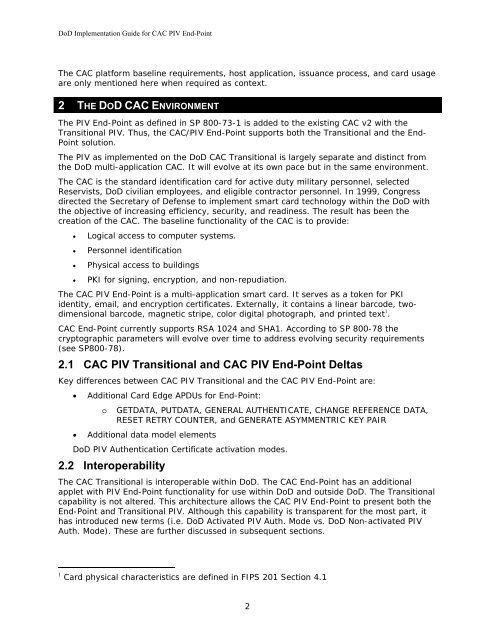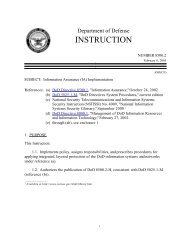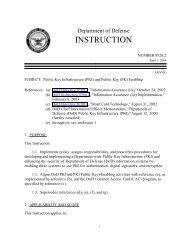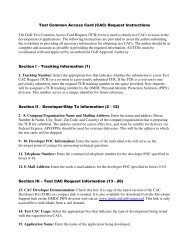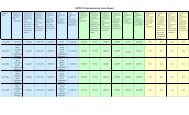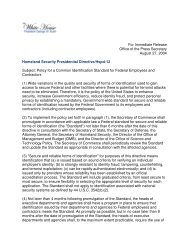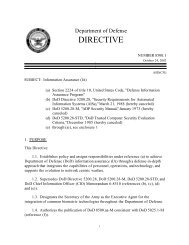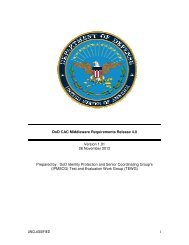DoD Implementation Guide for CAC PIV End-Point - Common ...
DoD Implementation Guide for CAC PIV End-Point - Common ...
DoD Implementation Guide for CAC PIV End-Point - Common ...
You also want an ePaper? Increase the reach of your titles
YUMPU automatically turns print PDFs into web optimized ePapers that Google loves.
<strong>DoD</strong> <strong>Implementation</strong> <strong>Guide</strong> <strong>for</strong> <strong>CAC</strong> <strong>PIV</strong> <strong>End</strong>-<strong>Point</strong><br />
The <strong>CAC</strong> plat<strong>for</strong>m baseline requirements, host application, issuance process, and card usage<br />
are only mentioned here when required as context.<br />
2 THE DOD <strong>CAC</strong> ENVIRONMENT<br />
The <strong>PIV</strong> <strong>End</strong>-<strong>Point</strong> as defined in SP 800-73-1 is added to the existing <strong>CAC</strong> v2 with the<br />
Transitional <strong>PIV</strong>. Thus, the <strong>CAC</strong>/<strong>PIV</strong> <strong>End</strong>-<strong>Point</strong> supports both the Transitional and the <strong>End</strong>-<br />
<strong>Point</strong> solution.<br />
The <strong>PIV</strong> as implemented on the <strong>DoD</strong> <strong>CAC</strong> Transitional is largely separate and distinct from<br />
the <strong>DoD</strong> multi-application <strong>CAC</strong>. It will evolve at its own pace but in the same environment.<br />
The <strong>CAC</strong> is the standard identification card <strong>for</strong> active duty military personnel, selected<br />
Reservists, <strong>DoD</strong> civilian employees, and eligible contractor personnel. In 1999, Congress<br />
directed the Secretary of Defense to implement smart card technology within the <strong>DoD</strong> with<br />
the objective of increasing efficiency, security, and readiness. The result has been the<br />
creation of the <strong>CAC</strong>. The baseline functionality of the <strong>CAC</strong> is to provide:<br />
• Logical access to computer systems.<br />
• Personnel identification<br />
• Physical access to buildings<br />
• PKI <strong>for</strong> signing, encryption, and non-repudiation.<br />
The <strong>CAC</strong> <strong>PIV</strong> <strong>End</strong>-<strong>Point</strong> is a multi-application smart card. It serves as a token <strong>for</strong> PKI<br />
identity, email, and encryption certificates. Externally, it contains a linear barcode, twodimensional<br />
barcode, magnetic stripe, color digital photograph, and printed text 1 .<br />
<strong>CAC</strong> <strong>End</strong>-<strong>Point</strong> currently supports RSA 1024 and SHA1. According to SP 800-78 the<br />
cryptographic parameters will evolve over time to address evolving security requirements<br />
(see SP800-78).<br />
2.1 <strong>CAC</strong> <strong>PIV</strong> Transitional and <strong>CAC</strong> <strong>PIV</strong> <strong>End</strong>-<strong>Point</strong> Deltas<br />
Key differences between <strong>CAC</strong> <strong>PIV</strong> Transitional and the <strong>CAC</strong> <strong>PIV</strong> <strong>End</strong>-<strong>Point</strong> are:<br />
• Additional Card Edge APDUs <strong>for</strong> <strong>End</strong>-<strong>Point</strong>:<br />
o GETDATA, PUTDATA, GENERAL AUTHENTICATE, CHANGE REFERENCE DATA,<br />
RESET RETRY COUNTER, and GENERATE ASYMMENTRIC KEY PAIR<br />
• Additional data model elements<br />
<strong>DoD</strong> <strong>PIV</strong> Authentication Certificate activation modes.<br />
2.2 Interoperability<br />
The <strong>CAC</strong> Transitional is interoperable within <strong>DoD</strong>. The <strong>CAC</strong> <strong>End</strong>-<strong>Point</strong> has an additional<br />
applet with <strong>PIV</strong> <strong>End</strong>-<strong>Point</strong> functionality <strong>for</strong> use within <strong>DoD</strong> and outside <strong>DoD</strong>. The Transitional<br />
capability is not altered. This architecture allows the <strong>CAC</strong> <strong>PIV</strong> <strong>End</strong>-<strong>Point</strong> to present both the<br />
<strong>End</strong>-<strong>Point</strong> and Transitional <strong>PIV</strong>. Although this capability is transparent <strong>for</strong> the most part, it<br />
has introduced new terms (i.e. <strong>DoD</strong> Activated <strong>PIV</strong> Auth. Mode vs. <strong>DoD</strong> Non-activated <strong>PIV</strong><br />
Auth. Mode). These are further discussed in subsequent sections.<br />
1 Card physical characteristics are defined in FIPS 201 Section 4.1<br />
2


